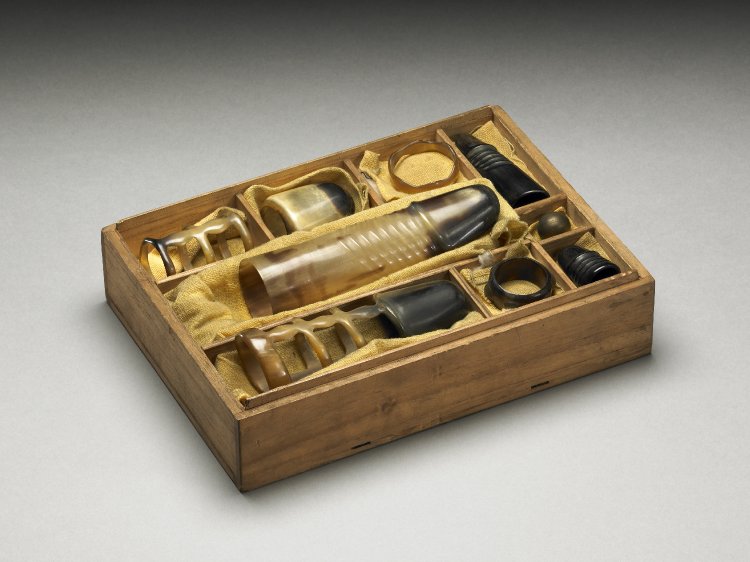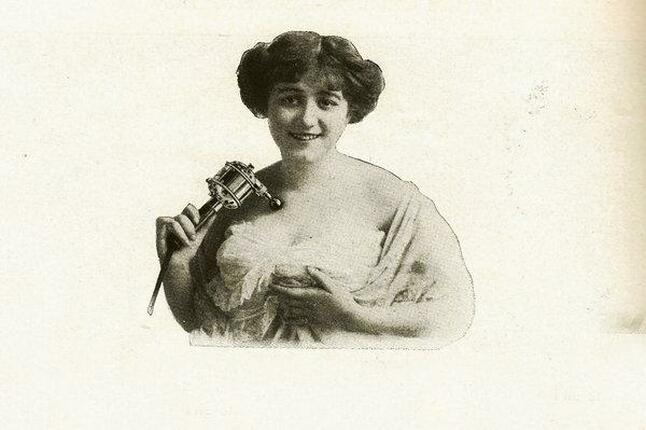|
Heini-Sofia Alavuo is a Finnish journalist currently living in Greece. She gets inspired by cats, saucy ancient Greek mythology and memes. Twitter: @heinialavuo Generally, we like to to think that society is constantly progressing, and tackling issues that have bothered us since the beginning of humankind. The idea of sexual revolution fits this narrative perfectly – from oppression to liberation we have now entered an era of openness and acceptance. The huge growth of sex toy market seems to prove this – in 2017 it was a $15 billion-dollar industry. Sex toys are mainly marketed for women, so one could think that women’s masturbation has been destigmatized. But, despite the huge variety of sex toys and erotica items, the so called revolutionary factor seems to be missing. Does the sex toy industry actually strive to empower women or is just an illusion? One way to study female sexuality is to examine the sex toy industry and its history.  20th century set of woman's 'toilet' implements for sexual gratification, consisting of five dildoes of assorted sizes, three rings and a ringing metal ball. Made of horn, metal. In wooden storage box (lid missing). © The Trustees of the British Museum 20th century set of woman's 'toilet' implements for sexual gratification, consisting of five dildoes of assorted sizes, three rings and a ringing metal ball. Made of horn, metal. In wooden storage box (lid missing). © The Trustees of the British Museum Persistent myths Probably everyone has heard that Victorians invented the vibrator for doctors to treat hysteria in women. This is actually just a widespread myth based on a book called The Technology of Orgasm by Rachel Maines in 1999. In August 2018, Hallie Lieberman and Eric Schatzberg published Failure of Academic Quality Control – Technology of Orgasms revealing that Maine’s book was never properly fact-checked and that her writings had no reliable sources or evidence behind them. Lieberman and Schatzberg found evidence showing that “massage of female genitals was never a routine medical treatment for hysteria.” (Lieberman, Schatzberg 2018) In an article for The Atlantic Lieberman analysed the reasons why the vibrator myth became so widely accepted and why it escaped any academic fact-checking procedures. She argued that the myth fit into the idea of constant progress being embedded into our society, and this way of thinking also “fits into ideas that people had that women’s sexuality wasn’t understood.” (Fetters and Meyers, 2018) That made me wonder… do we actually understand, or furthermore, accept, women’s sexuality today? What is life without a dick? Throughout history, toys have been very phallic, imitating a male penis in all possible sizes, colours and materials. Even Freud could not have imagined such phallic fiesta. One of the first recorded sex toys was a silt stone dildo dating to 26000 BCE. Ever since humans have been able to craft tools, we’ve been able to find ways to enjoy sex more. The 1960s and 70s were a boom time for the dildo market as toys of varying colours, shapes, and textures were mass produced. The mid 1970s saw the introduction of non-realistic looking dildos in non-realistic colours. (New York Magazine, 2017) Many of these dildos were manufactured for couples to use together. But even when they were marketed at women to use independently, the shape persisted. Maybe the assumption was that women could only feel pleasure with a penis. If masturbation was seen as practice of ladies suffering from dick-deficiency, it only makes sense that the toys try to imitate the real deal. This way, even when a woman was pleasing herself, a man were still present.  The “White Cross Electric Vibrator Girl” as pictured in a 1911 Health and Beauty catalog. CreditCreditCourtesy American Medical Association Archives The “White Cross Electric Vibrator Girl” as pictured in a 1911 Health and Beauty catalog. CreditCreditCourtesy American Medical Association Archives Buzz, buzz The first electric vibrators were sold in early 1900s as “beauty devices” that could treat anything from wrinkles to a sore throat. This discreet marketing according to defined gender roles made them nonthreatening and silently accepted. (New York Magazine, 2017) Today, we have buzzers in variety of sizes, shapes, colours and materials. In her book Buzz: The Stimulating History of the Sex Toy, Lieberman points out that the way majority of women’s sex toys are designed shows the condescension around female sexuality. Many are shaped like children’s toys, exposing the hidden attitude towards female sexuality – it’s something funny and skittish, not important. Unlike dildos, vibrators are not anatomical replicas of the divine dick. This clearly indicates that vibrators are something for female pleasure only. In late 1960s vibrators shook the society when Betty Dodson, one of the lead feminists of the time in America, announced that masturbation could liberate women from the sexual dependency of men. The world-known vibrator Hitachi Magic Wand appeared at the same time, becoming the first political sex toy – “suddenly sex toys were also a sign of liberation and female power.” (New York Magazine, 2017) Love thyself Masturbating women are scary in a society that has been built on the fact that women are dependent on men, for example economically or sexually. Sexually active and free women around the world are often also perceived as wicked and uncontrollable, and that’s exactly what the patriarchy is about – the control of women. So masturbation can be a form of liberation and a way to break free from social expectations. The ever growing sex toy industry has made it easier for women to get sexual pleasure, but the available toys are not as great as they could be - mostly because our society doesn’t fully accept masturbating women yet. Lieberman’s research on the industry led her to argue that the sex toy industry is actually quite regressive. In an interview with Bitch magazine she states that in reality sex toys are accepted only as long as they are used within the defined norms. Many sex toys fit into female gender roles and are sold as couple’s toys that can spice up the relationship between two, usually heterosexual, people. (Weiss, 2019) It’s also fear that keeps the industry from offering fantastic toys for women – enjoyable toys have been seen to replace men or partners. An episode of Sex and the City addresses this thought directly: after getting the world-famous Rabbit, Charlotte only wants to be with her new best friend instead of meeting men. Nothing to worry - toys can’t replace human contact. It’s completely ok for women to be in charge of their own desires, and this is what proper sex toys can give us. Politics and dicks In her book Lieberman writes: “I had thought that the whole existence of the sex toy industry was a sign of the liberation that had come out of the sexual revolution. My time in the industry itself taught me that maybe we hadn’t come quite as far as I had believed … [sex toys] were the physical embodiment of the conflicted relationship the modern world had with sexuality”. (Lieberman, 2017) The modern world struggles with inclusive feminism, which is slowly opening more space in the society for independent women, LGBTQ+ people and disabled folk. Although there are some progressive sex toy companies, the mainstream industry hasn’t decided to push for reconstruction of restrictive norms. When sex toys came to the market they were something revolutionary, but as times change the industry has been stuck instead of openly embracing the triumph of independence and diversity. As we enter an era where gradually more women are in the lead of sex toy companies, women’s toys have become more enjoyable: women design toys with women’s anatomy and pleasure in mind. The market for revolutionary toys is still rather small, and there’s a lot room for the market to evolve. Some progressive companies have also noticed that the industry shouldn’t be based on heteronormativity, and few have started providing toys for all sexes and sexualities. Ideally, the sex toy industry could even work as a ground breaker for these social changes – empowering women and all people to explore their sexuality and enjoying pleasure. As consumers we can demand change by supporting companies that are willing to lead the way towards a future where pleasure is accessible to all, without judgement. By talking openly we can also add more understanding and acceptance of female sexuality, and sexuality in general. Reference list:
1 Comment
1/13/2022 12:36:05 am
I never knew that many of these dildos were manufactured for couples to use together. I never thought that it would be like this, it is a good article to read, I'll share this with my aunt. Thank you for the information about women's sex toys.
Reply
Leave a Reply. |
Sex History ContentsIf you would like to submit an article, please fill out a submission on the Contact page Archives
September 2020
|

 RSS Feed
RSS Feed